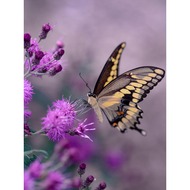Blue Sky
(View Complete Item Description)This activity provides instructions for using a flashlight and aquarium (or other container of water) to explain why the sky is blue and sunsets are red. When the white light from the sun shines through the earth's atmosphere, it collides with gas molecules with the blue light scattering more than the other colors, leaving a dominant yellow-orange hue to the transmitted light. The scattered light makes the sky blue; the transmitted light makes the sunset reddish orange. The section entitled What's Going On? explains this phenomena.
Material Type: Activity/Lab




















